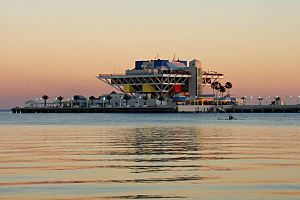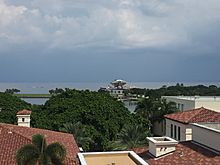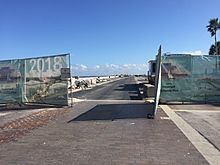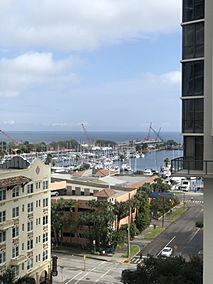St. Petersburg Pier facts for kids

St. Petersburg Pier in May 2020
|
|
| Official name | St. Pete Pier |
|---|---|
| Type | Pleasure pier |
| Spans | Tampa Bay |
| Locale | St. Petersburg, Florida, United States |
| Design | ASD Architects Rogers Partners Architects+Urban Designers Ken Smith |
| Owner | City of St. Petersburg |
| Opening date | |
| Coordinates | 27°46′24″N 82°37′19″W / 27.77333°N 82.62194°W |
The St. Petersburg Pier, also known as the St. Pete Pier, is a famous pier that stretches into Tampa Bay from downtown St. Petersburg, Florida. It's a fun place for people to visit and enjoy the water.
Over the years, several different piers have been built in the same spot. The most recent one, before the current pier, was a five-story building shaped like an upside-down pyramid. This "Inverted Pyramid Pier" closed in 2013.
The new St. Pete Pier opened on July 6, 2020. It's a big area, about 26 acres, and cost $92 million to build. It has five restaurants, a playground, a center for learning about the environment, and cool artworks. Some of the art includes pieces by Xenobia Bailey, Nathan Mabry, Nick Ervinck, and a large sculpture called Bending Arc by Janet Echelman. The opening was planned for May 30, 2020, but was delayed because of the COVID-19 pandemic in Florida.
Contents
History of the St. Pete Pier
Before the main piers were built, there were smaller piers in St. Petersburg starting in 1854. These piers helped people get to and from boats in Tampa Bay.
Early Piers and Their Beginnings
The first big pier was built in 1889 by the Orange Belt Railway. It was called the Railroad Pier and stretched about 2,000 to 3,000 feet into Tampa Bay. This pier allowed steamboats and cargo ships to dock. It also became a tourist spot, with a bathing area added later.
Another pier, the Brantley Pier, was built in 1896. It was 1,500 feet long and also had a bathing area. These piers competed for visitors. A newspaper editor, William Straub, pushed for the waterfront areas to become public parks.
In 1901, the Fountain of Youth Pier opened. It had a small house at the end and a well that people hoped had special "youth-giving" water.
The Brantley Pier was taken down in 1904. In its place, the Electric Pier was built in 1905. This pier was 3,000 feet long and lit up with light bulbs. It even had an electric trolley to carry people and goods.
The city of St. Petersburg built its first pier, the Municipal Recreation Pier, in 1913. It cost $40,000 and was meant only for fun activities to attract tourists. The Electric Pier was taken down a year later.
The Million Dollar Pier Era
A big hurricane hit Tampa Bay in 1921, damaging most of the piers. The Fountain of Youth Pier was destroyed. After the storm, people realized a new, stronger pier was needed.
A local newspaper publisher, Lew B. Brown, helped gather money for a new pier. People donated $300,000, and the city added more funds. In 1925, voters approved a $1 million bond for the project. Construction began that same year.
The new pier, called the Million Dollar Pier, opened on November 25, 1926. It was 1,452 feet long and 100 feet wide. At the end of the pier was a beautiful building called the Casino. It had a large open area for cars, a ballroom, a theater, and a place to look out over the bay. The pier also had a beach and a streetcar line.
By the mid-1960s, the Million Dollar Pier started to get old and needed a lot of repairs. So, in 1967, the Casino building was taken down.
The Inverted Pyramid Pier

After the old Casino was gone, the end of the pier became a park with benches. The city then looked for ideas for a new pier. In 1969, they chose a design by William B. Harvard Sr. for an "Inverted Pyramid Pier." This design was chosen because it would not block the view of Tampa Bay.
The Inverted Pyramid Pier opened on January 15, 1973. It cost about $4 million. The building had large windows for amazing views of Tampa Bay and a big top floor for observation.
In 1976, a special laser sculpture was added to the pier. It shone a green laser beam from the pier towards downtown St. Petersburg, reflecting it back and forth. However, it had many problems and was eventually shut down.
The Inverted Pyramid Pier closed for repairs in 1986 and reopened in 1988 after a $12 million renovation.
By 2004, the city found that the Inverted Pyramid Pier was too expensive to keep up. They decided a new pier was needed. In 2009, a special group was formed to find a new design. The Inverted Pyramid Pier officially closed on May 31, 2013.
Building the New Pier
The Lens Project
After the Inverted Pyramid Pier closed, the city council decided to replace it. In 2012, a design called "The Lens" was chosen for the new pier. This design was picked from 29 different ideas.
However, many people in the city did not like "The Lens" design. They wanted to save the old pier or have a different design. In August 2013, the people of St. Petersburg voted to cancel the contract for "The Lens" project.
Pier Park: The Current Design
After "The Lens" was rejected, the mayor, Rick Kriseman, started a new process to find a design. A group called the Pier Working Group was created to get ideas from the community for the new pier.
Many teams submitted new designs. In early 2015, the public was able to see the different ideas and vote for their favorites. The "Destination St. Pete Pier" was a popular choice, but "Pier Park" also received many votes.
Finally, on April 23, 2015, a committee chose "Pier Park" as the top design. The St. Petersburg City Council approved the "Pier Park" plans on May 7, 2015.
Demolition of the old pier began on August 18, 2015. By November 2015, the main structure of the Inverted Pyramid Pier was completely gone. The rest of the old pier was taken down by late 2016.
Construction for the new Pier Park started on June 28, 2017. The project received more funding, bringing its budget to $76 million. By December 2017, much of the pier's foundation was in place.
In 2018, it was announced that three artists, Nick Ervinck, Nathan Mabry, and Xenobia Bailey, would create public art for the pier area. A sculpture by Janet Echelman was also approved. The main building construction began in November 2018.
The new St. Pete Pier officially opened on July 6, 2020, after a delay due to the COVID-19 pandemic. It is now a vibrant 26-acre district with many attractions for everyone to enjoy.
Images for kids





